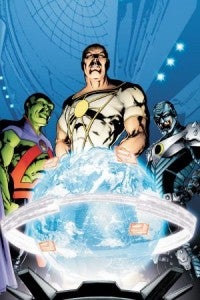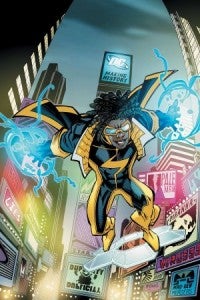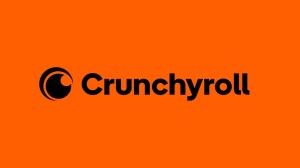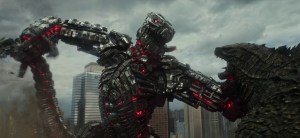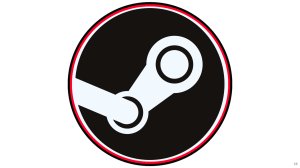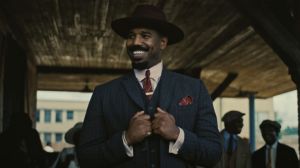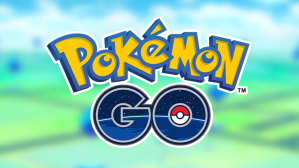I know I said “come back tomorrow, and that it was two or three days ago, but yesterday I finally got un-evacuated and am living in my home again. This meant a lot of cleaning, and grocery shopping, and general chaos. Plus a They Might Be Giants concert.At any rate, since the new issues come out today and you’ll be hearing more from me soon, let’s jump right into the last of last week’s titles.Hawk & Dove #1 – **1/2Written by Sterling Gates; Art by Rob Liefeld and Matt YackeyFirst of all: “Nobody likes zombies anymore”? That sounds like a shot across the bow of Robert Kirkman, Rob Liefeld’s collaborator on Image’s much-hyped The Infinite. Well played, Mr. Gates…well played.But seriously, folks, Hawk & Dove’s biggest liability isn’t Rob Liefeld’s art, as many would have you believe. It’s that someone—either DC or Gates or both—apparently couldn’t bear to part with ANYTHING from the characters’ histories and so in spite of a lengthy and somewhat sloppy chunk of exposition in the middle of the issue, it seems like it would be the hardest for new readers to jump into. In one issue, they reference the Crisis on Infinite Earths, Brightest Day and baffle the reader with the question of how all of this could have happened to Hank, who appears to be much younger than previously established. This makes sense, given that Hawk & Dove is being promoted as one of DC’s “Young Justice” line of titles but at the same time it makes all that history pretty daunting. Maybe we’ll find that the avatar of war has a bit of post-traumatic stress disorder after having the most harrowing five years anybody’s ever experienced.Alexander Quirk, the villain who seems to be pulling all the strings in this series, is an interesting guy but seems better-suited to the Animal Man/Swamp Thing corner of the DCU than the part where all the teenagers hang out.Oh, and just in time for the tenth anniversary of 9/11, the bad guys (with a little help from Hawk and Dove) crash a hijacked plane into the Washington Monument.Justice League International #1 – *****Written by Dan Jurgens; art by Aaron Lopresti and Matt RyanProbably the title I personally looked the most forward to, Justice League International picks up the adventures of Booster Gold by Dan Jurgens—but quietly sweeps most of the character’s recent backstory under the rug. While an interaction between Guy Gardner and Batman seems to suggest that at least some of Booster’s recent adventures did occur, to the world these characters have never been a team before and Booster is “Not Green Lantern—that guy from the beer commercial.”That’s not a complaint, though; just an observation. Jurgens handles the challenges of reintroducing these characters well, hinting that some of them have some semblance of a backstory but never succumbing to the temptation to over-clarify. Did Ted Kord ever exist? Dan DiDio says no, but the comics aren’t saying. Will Rip Hunter, Booster’s son, still be the A #1 Time Master on the planet? Who knows?But Guy is still angry and ranting; Batman is still a bit of a control freak and Booster is balancing the serious business of saving the world with a need to manage his image. It is what the relaunch was meant to be—not a full reboot, but a boiling down of each character to their essence, allowing them to be accessible to as wide an audience as possible and offering new storytelling possibilities along the way. “Who is Rip’s mother?” has been replaced with “Will Booster hook up with Godiva?” and while I can understand the frustration some readers feel over that kind of change, I don’t feel it myself.Introducing wild cards like Godiva and the August General-In-Iron make the title unpredictable in a way that you wouldn’t expect for Jurgens’s second tour on a Justice League book featuring Guy, Fire, Ice and Booster. Even as a veteran writer, he’s taken the relaunch and its challenges seriously and met them head-on with what feels like absolute success.Aaron Lopresti, who blew the doors of Justice League: Generation Lost last year, turns in a capable and attractive first issue. He still doesn’t appear to be firing on all cylinders in terms of some of the costume redesigns, but for the most part it isn’t distracting and the fluidity of motion in his storytelling is second to very few.All in all, probably my favorite book of the relaunch…but, yes, I’m biased.See a conversation between myself and Dan Jurgens about this issue at The Outhouse, and check out the story I ran here this weekend talking about some of the issues surrounding the relaunch.Men of War #1 – ***Written by Ivan Brandon and Jonathan Vankin; art by Tom Derenick and Phil WinsladeWhile I can appreciate the craft of this book and respect what they’re trying to do, this was probably my personal least-favorite read of the week, in terms of sheer entertainment value. That might serve to pigeonhole me as too much of a superhero fan, but we all have our crosses to bear.Revolving around the grandson of the Sgt. Rock we all know and love, he’s a guy who’s more comfortable as a face in the crowd than he would be as an officer, and so he’s self-destructive. It’s a fascinating psychology to explore, and one that’s particularly interesting given that mostly what you see in militar families (the way they’re depicted in the media, not necessarily in life) is that they’re profoundly driven for the next promotion.Due to the events of this issue, though, we won’t get much of a chance to explore that aspect of his psychology—or if we do, it’ll be buried in other issues.The solicitations seem to suggest that Easy Company is a group of ex-military men working under contract, presumably like a less evil Blackwater-type firm. There’s really nothing to support that in the narrative, though, as it seems to jump right from his C.O. saying, “I’ve got a proposal for you…” to the chopper.The issue plods along for me, with the only real bright spot being the inspired decision to provide a key to the slang for the non-weapons-savvy and the backup feature really steals the spotlight with some truly terrific art from Phil Winslade. If the features were reversed I actually might have more of an attraction to this book, but as it stands I just think I’m not the target demographic.
The New 52 Review Revue: Week One, Part 2
I know I said ‘come back tomorrow, and that it was two or three days ago, but yesterday I finally […]


